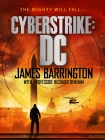Cyberstrike, James Barrington [short story to read .TXT] 📗

- Author: James Barrington
Book online «Cyberstrike, James Barrington [short story to read .TXT] 📗». Author James Barrington
All that changed in 2019 when a company based in Cicero, just outside Syracuse, developed a ground-based radar known as LSTAR that could accurately detect all aircraft, including drones, and determine a contact’s altitude even if it didn’t have a functioning transponder. The new radar had been created for an entirely different purpose – to detect and track incoming mortar rounds as fast as possible in a battle situation to allow retaliatory fire – but despite its comparatively short range it had proved to be capable of monitoring air traffic around Syracuse both accurately and reliably.
In the thirty-foot-long air-conditioned ground control station, No Sweat Nagell sat in a comfortable chair that looked more like the kind of seat to be found in an upmarket airport lounge than in a military establishment, but with Predator and Reaper drones routinely able to remain aloft for twenty-four hours, and with even longer duration UAVs on the drawing board, the comfort of the remote pilot was a paramount consideration.
In front of him was a control panel, the most important element of which was a fairly standard flight stick, a multipurpose vertical lever that could control most aspects of the Reaper’s flight path. The pilot would use that just as if he were sitting in the cockpit of a conventional aircraft, the main difference being that the inputs he made were transmitted to the UAV initially using a C-band line-of-sight data link. The other difference was that all the pilot had to rely on, his eyes, as it were, were the video screens in front of him that displayed the feeds from the Reaper’s on-board radars and cameras and provided a limited view of what was in front of the UAV. This was nothing like the all-round vision experienced by a pilot flying any kind of an aircraft, hence the ‘looking through a straw’ analogy.
Once the drone moved outside line-of-sight range, as was the case when the pilot was sitting in a GCS in Montana or Nevada or somewhere, but the Reaper was taking off from an airfield near Mosul or Kabul, almost literally on the other side of the world, the routine was somewhat different in that a local pilot would handle the taxiing, take-off and initial climb out of the vehicle and then hand over control to the remote pilot once the drone had reached a safe altitude. Control from then on, until the mission had been completed and the drone was returning to its base, would be handled via a Ku-band L-3 Com satellite data link system. Recovery was the reverse of take-off, the local pilot again taking control as the drone approached its home airfield and then handling the landing and taxiing to its hangar or shelter.
For this flight, Nagell would be both the local pilot and the remote pilot and would be using both the line of sight and satellite communication systems to control the drone at different stages and locations. He levelled the Reaper at 30,500 feet, adjusted the speed and heading and then relaxed as the drone continued on its planned track towards the southern shore of Lake Ontario. The on-board radar showed no contacts close enough to be a problem and even the limited view through the cameras confirmed that it was a lovely day out there.
With a bit of luck, Nagell thought, the weather might hold until he could hand over to the second pilot in a few hours and head off home to enjoy what was left of Independence Day.
Chapter 47
Washington D.C., United States of America
Ben Morgan picked up a filter coffee from the counter of the Hard Rock Cafe on the corner of 10th Street and E Street, almost opposite but just out of sight of the FBI building. That was the only hot – or in this case still very warm – drink the staff could offer because all of their machines had shut down due to the blackout. Then he took a seat at an outside table. As he did so his mobile beeped. He opened it up to see he’d received a message containing a longish piece of text, a big data file and several audio files, all from Natasha Black.
He read the message and scanned the data file but didn’t bother listening to the audio files because of what he read in the message. The audio files, Natasha explained, were the original take from the GCHQ intercepts, but the participants only spoke in Arabic, knowledge of which, she pointed out in her usual slightly acerbic manner, was not part of Ben Morgan’s very limited skill set. The analyst at Cheltenham, or more likely one of the linguists on the staff there, had translated the Arabic messages into English and included the results within the data file, as well as the contents of a handful of SMS messages, all of which had been written in English.
By the time he’d finished his coffee he’d read the entire file. He knew nothing more about the putative attack than he had done before he’d started, but he did have several pieces of potentially vital information, none of which were the slightest bit of use to him personally, but which he knew that the FBI – or at least Grant Rogers – could, and should, be able to act on. Just as a precaution, he took out a notebook and pen from his pocket and made a written note of the most important data.
You can always rely on a pen and paper when everything else fails and, looking up and down the street at the noisy chaos being caused by the non-functioning traffic lights and the increasing number of people now wandering along the sidewalks, Morgan reckoned the





Comments (0)